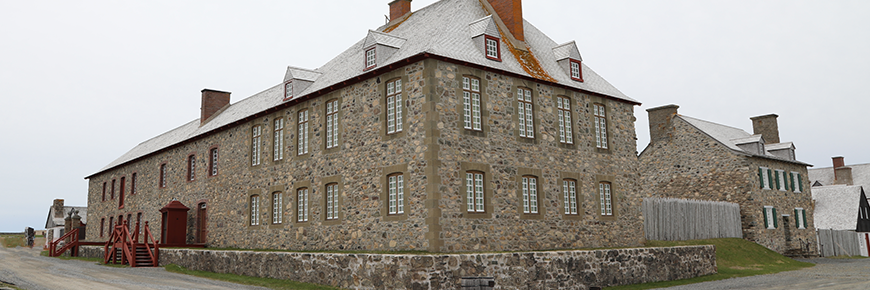
Commissaire-Ordonnateur’s Property
Fortress of Louisbourg National Historic Site
Close scrutiny of this big building can reveal how an empire was run. To maintain royal sway over far-flung colonies, paperwork was as vital as fortresses and fleets. While the engineer built Louisbourg and the governor symbolized its authority, the man who lived here kept the colony running.
In the offices overlooking the quay, the administrator and his clerks filled up books of correspondence, maintained the colonial accounts, and compiled their statistical reports for the Ministry of Marine. They paid the colony’s bills from the well-guarded treasury here — see the barred windows — and filled the storerooms behind with their supplies. Everything from economic policy to civil justice was managed from here, and the power of the commissaires-ordonnateurs sometimes excited the governors’ jealousy. Built as a private residence, the house became royal property in 1733 and expanded with the power of its occupants.
The administrators were professional servants of the Crown who hoped to win promotion by proving themselves here. François Bigot established his reputation by able and devoted service as Île Royale’s commissaire-ordonnateur from 1739 to 1745, while his sharp investments simultaneously laid the foundation of his wealth. Duly promoted, he went on to both fortune and disgrace as the last Intendant of New France.
The top floor houses an exhibit, Vestiges of Louisbourg, which contains artifacts from 18th century Louisbourg, and a gallery with paintings and ship models recreating aspects of Louisbourg’s busy port.
The stables behind the residence, at the corner of Rue Royale, are another sign of authority. Boats were needed more than horses in this colony. Few homeowners built large stables like these and a horse and carriage proclaimed wealth and prestige.
Across Rue Saint-Louis from the commissaire-ordonnateur’s property, a space was reserved for the parish church of Notre-Dame des Anges. The church was never built, but Louisbourg’s Récollet missionaries had a little chapel in their residence at the back of the block.
Related links
- Desroches House
- Dauphin Demi-Bastion and Gate
- Embrasures at Lartigue
- Lartigue House
- Artillery Storehouse and Forge
- The King's Bakery
- Duhaget Property
- De la Perelle Property
- Engineer's Property
- Rodrigue Property
- De Gannes Property
- The King's Bastion
- McLennan Centre
- Through the town to the quay / De la Plagne Property
- De la Vallière Property
- Carrerot Property
- Benoist Property
- L’Epée Royale
- Magasin du Roi (King's Storehouse)
- Hôtel de la Marine
- Grandchamp Property
- Frédéric Gate
- Marie Marguerite Rose plaque
- Eastward along the Quay
The reconstructed site

| On the map | Building name |
|---|---|
| 1 | Desroches House (Wheelchair accessible) |
| - | Dauphin Gate |
| - | Dauphin Demi-Bastion |
| 2 | Powder Magazine |
| 3 | Barracks |
| 4 | Postern Tunnel |
| 5 | Embrasures at Lartigue |
| 6 | Lartigue House (Wheelchair accessible) |
| - | Lime Kiln |
| 7 | Artillery Storehouse |
| 8 | Artillery Forge |
| 9 | King's Bakery Food service |
| - | Woodlot |
| 10 | Duhaget House (Wheelchair accessible) Garrison and Fortifications Exhibit |
| - | Icehouse |
| 11 | De la Perelle House (Wheelchair accessible) Congrégation de Notre-Dame Exhibit |
| 12 | De la Perelle Storehouse |
| 13 | Engineer's Residence |
| 14 | Laundry and Stables |
| 15 | Rodrigue House |
| 16 | Rodrigue Storehouse |
| 17 | De Gannes House (Wheelchair accessible) |
| 18 | Guardhouse |
| - | King's Bastion |
| 19 | Military Chapel |
| 20 | Governor's Apartments |
| On the map | Building name |
|---|---|
| 21 | King's Bastion Barracks Reconstruction, Tools of War, and Archeological Typography Exhibits |
| - | King's Garden |
| 22 | McLennan Centre (Wheelchair accessible) (Wifi available) Virtual Reality Experience |
| 23 | De la Plagne (Wheelchair accessible) (Information) |
| 24 | De la Vallière House Mi'kmaw Interpretive Centre |
| 25 | De la Vallière Storehouse |
| 26 | De la Vallière Storehouse II |
| - | Fizel and Loppinot Properties |
| - | Dugas House |
| 27 | Carrerot House Building Techniques Exhibit |
| 28 | Benoist House (Wheelchair accessible) (Gift shop) |
| 29 | L'Épée Royale Café (Wheelchair accessible) Food service |
| 30 | King's Storehouse |
| 31 | Hôtel de la Marine (Wheelchair accessible) Food service |
| 32 | Grandchamp House (Wheelchair accessible) Food service |
| - | Frédéric Gate |
| - | Carcan |
| 33 | Grandchamp Inn (Wheelchair accessible) Food service |
| - | Destouches House |
| 34 | Ordonnateur's Residence (Wheelchair accessible) Recollecting Lives Exhibit & Harbour Gallery |
| 35 | Bigot Storehouse |
| 36 | Stables |
| - | Louisbourg Cross |
| 37 | Marie Marguerite Rose plaque |
| - | Eastward along the Quay |
| - | Ruins Walk |
- Date modified :